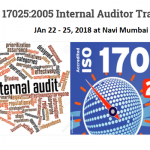Conducting effective internal audits as per ISO 9001, 14001, OHSAS 18001, ISO 22000, ISO 17025 and ISO 27001 standards
Your Rating
User Rating:
0 (0 votes)
- Identify what all requirements from the ISO standard will be applicable to the particular department you are auditing & check compliance of all of them. This is very important as you need to first start with ISO 9001/14001/17025/18001/22000/ 27001standard requirements applicable to that department, make a checklist using ISO standard as a reference and cover it. Never jump to the SOP straight away without covering ISO standard requirements.
- Always ask open ended questions and never ask close ended questions.
- Once you get SOP see if it is in editable or non-editable form. It must be the pdf form or if paper based then must be stamped as controlled copy.
- Check for input and output of the sop. They must be clearly identified.
- Check for description of the process in SOP. It must be nicely written that covers what a department does for that process in reasonable depth.
- Check for reference documents as mentioned in the reference doc part SOP. All the documents mentioned must be available and followed.
- Check for any other documents they are using but not part of SOP.
- Ask for quality objective list. Make sure the quality objectives are measurable and time bound.
- Check about awareness of quality policy and quality objectives with HOD, process owner and other employees. They must be knowing if not completely but partly.
- Ask for plan for achieving of quality/environmental/health & safety/information objectives,
- Ask for tracking of quality/ environmental/health & safety/information objectives. Achievement data must be available against each objective.
- Verify document control for changes made in the documents and whether the change process was followed correctly. Verify the same with MR and also ask about retention period and see the old records are destroyed or archived accordingly.
- Take notes while auditing
- Summarize the findings and find out NCs
- Share with the auditee and ensure that the NCs are accepted by the auditee. No NC is to be given until it is accepted by the auditee. If auditee accepts it then prepare NC report with objective evidence and give it to the auditee.
- Follow-up with the auditee to ensure actions are taken within the predetermined time frame.







